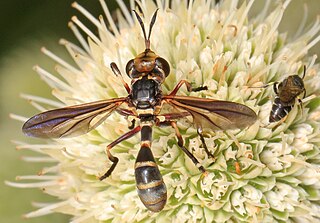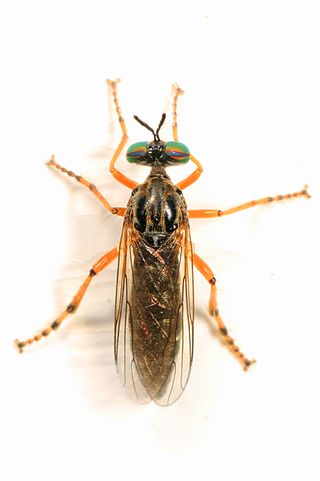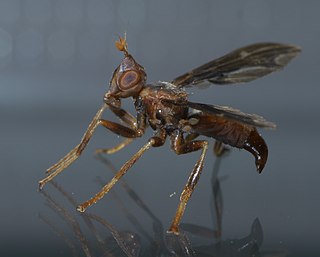
Hover flies of the genus Microdon are unusual among the Diptera. Like other members of the subfamily, they are myrmecophiles, meaning they inhabit the nests of ants.

Mallota is a widely distributed Holarctic genus of hoverfly, well known for their bee-like appearance.

Physocephala is a genus of flies from the family Conopidae.

Zodion is a large genus of flies from the family Conopidae.
Chymophila is a subgenus of the hoverfly genus Microdon. It was previously considered to be exclusively Neotropical, but is now also known from the Nearctic and Oriental realms, and one species is known from Japan. Chymophila was based on a composite type species: the holotype is a body of C. fulgens with the head of a conopid glued on.

Ocyptamus is a large and diverse genus of over 200 species of hoverfly mostly found in the Neotropical region. It is likely that many of these species will be discovered to be synonyms though many others await description.

Palpada is a genus of 85 neotropical and nearctic flower flies or hoverflies This genus is often colorful and bee-like. It is in the tribe Eristaliini containing dozens of genera Common sister genera include Eristalis (99 species), Meromacrus (43 sp.), Eristalinus (100 sp.) and Helophilus (50 sp.). The genus palpada is distinguished by:

Cyphomyia is a genus of flies in the subfamily Clitellariinae.

Physoconops is a genus of thick-headed flies in the family Conopidae. There are about 13 described species in Physoconops.
Stonyx is a genus of bee flies, insects in the family Bombyliidae. There are about five described species in Stonyx.
Poecilominettia is a genus of flies in the family Lauxaniidae. There are more than 60 described species in Poecilominettia.

Mydas is a genus of flies in the family Mydidae.
Dolichomyia is a genus of bee flies in the family Bombyliidae. There are about seven described species in Dolichomyia.

Cordilura is a genus of dung flies in the family Scathophagidae. There are more than 90 described species in Cordilura.

Camptoprosopella is a genus of flies in the family Lauxaniidae. There are more than 30 described species in Camptoprosopella.

Taracticus is a genus of robber flies in the family Asilidae. There are about 16 described species in Taracticus.

Pyrgota is a genus of flies in the family Pyrgotidae. There are about 10 described species in Pyrgota.

Hybobathus is a genus of hoverfly in the Neotropical region, formerly included in the genus Ocyptamus, which was split after researchers determined it was not monophyletic.
Sterphus is a genus of hoverflies.














